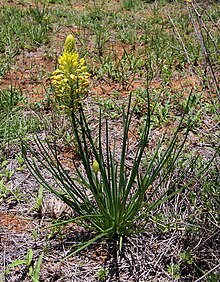en
names in breadcrumbs


Bulbine is a genus of plants in the family Asphodelaceae and subfamily Asphodeloideae,[3] named for the bulb-shaped tuber of many species.[4] It was formerly placed in the Liliaceae.[5] It is found chiefly in Southern Africa, with a few species extending into tropical Africa and a few others in Australia and Yemen.[6][2]
Bulbine is a genus of succulent plants with flowers borne in lax or compound racemes.[6] The flowers are usually yellow, with bearded stamens; some species have white, orange, or pink flowers.[6] Several species are grown in gardens, especially B. frutescens.[6] Species of Bulbine resemble Haworthia and Aloe in appearance, but with soft, fleshy leaves and tuberous roots or a caudex. They are shrubs, weedy perennials, dwarf geophytes (including B. lolita, the smallest of all succulent Monocots [7]), and soft annuals. Many of the dwarf species have small, dome-shaped tubers.
Dormancy usually extends from late spring to autumn, but it varies among species and in different conditions. The leaves die and drop, the roots contract into the caudex, and the aboveground parts wither. Propagation is mostly by seed, but some species form multiple heads or offsets and can be propagated with cuttings.


Species include:[8]
Bulbine is a genus of plants in the family Asphodelaceae and subfamily Asphodeloideae, named for the bulb-shaped tuber of many species. It was formerly placed in the Liliaceae. It is found chiefly in Southern Africa, with a few species extending into tropical Africa and a few others in Australia and Yemen.
Bulbine is a genus of succulent plants with flowers borne in lax or compound racemes. The flowers are usually yellow, with bearded stamens; some species have white, orange, or pink flowers. Several species are grown in gardens, especially B. frutescens. Species of Bulbine resemble Haworthia and Aloe in appearance, but with soft, fleshy leaves and tuberous roots or a caudex. They are shrubs, weedy perennials, dwarf geophytes (including B. lolita, the smallest of all succulent Monocots ), and soft annuals. Many of the dwarf species have small, dome-shaped tubers.
Dormancy usually extends from late spring to autumn, but it varies among species and in different conditions. The leaves die and drop, the roots contract into the caudex, and the aboveground parts wither. Propagation is mostly by seed, but some species form multiple heads or offsets and can be propagated with cuttings.
 Bulbine abyssinica, a common species that occurs throughout southern and east Africa.
Bulbine abyssinica, a common species that occurs throughout southern and east Africa.  Bulbine alooides, a species from the southern Cape, South Africa.
Bulbine alooides, a species from the southern Cape, South Africa.  Bulbine latifolia
Bulbine latifolia  Bulbine frutescens, a species very common in cultivation
Bulbine frutescens, a species very common in cultivation